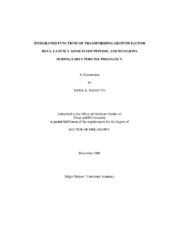| dc.description.abstract | In pigs and other mammals, embryonic losses often occur during implantation when the conceptus (embryo plus its extra-embryonic membranes) attaches to the maternal uterine epithelium. Mechanisms controlling this process are not completely understood. Integrins and growth factors are among many molecules likely involved in controlling implantation. Numerous integrins (ITG), including subunits ITGAV (alpha v), ITGB1 (beta 1), ITGB3 (beta 3), and ITGB5 (beta 5), and transforming growth factor betas (TGFBs), in both latent and active forms, are present at the porcine conceptus-maternal interface. TGFBs are released as latent precursors which cannot interact with TGFBRs prior to their activation. Latency associated peptide (LAP), part of the TGFB latent complex, contains an amino acid sequence Arg-Gly-Asp (RGD) that is found in other extracellular matrix molecules and may interact with and signal through integrins. We hypothesize that LAP will bind to and activate ITGAV-containing heterodimers at the conceptus-maternal interface and that these interactions are a functional component of implantation. We also hypothesize that TGFB acting via TGFBRs has critical roles during peri-implantation, and such roles may include promoting conceptus development, survival, and adhesion.
Immunofluorescence was used to colocalize TGFB, LAP, and integrins in porcine peri-implantation uterus and conceptus; immunohistochemistry of phosphorylated SMAD2/3 provided evidence of TGFB activity. Affinity chromatography identified cell surface integrins on porcine trophectoderm that are capable of binding LAP. In vivo, intrauterine infusions of LAP with its native RGD site (LAP-RGD) resulted in inhibition of conceptus elongation; LAP-RGE infusions yielded normal-appearing filamentous conceptuses at d13 of pregnancy. At d24, allantois length and fetal weights were greater in gilts which received LAP-RGE infusions compared to controls which received vehicle only.
Results provide evidence for 1) active and latent TGFB in porcine conceptus and uterus; 2) receptor-ligand interactions of integrins and LAP; 3) integrin aggregation and potential focal adhesion formation at the conceptus-maternal interface; and 4) TGFB- and/or integrin-associated mechanisms which regulate conceptus elongation and placental and fetal size. Collectively, results suggest that TGFB and integrins are extensively involved in communication at the porcine conceptus-maternal interface, particularly regulating conceptus development, adhesion, and placental and fetal development. | en |


